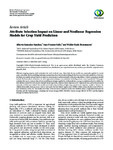Attribute selection impact on linear and nonlinear regression models for crop yield prediction

View/
Date
2014Author
González Sánchez, Alberto
Frausto Solís, Juan
Ojeda Bustamante, Waldo
Abstract
Efficient cropping requires yield estimation for each involved crop, where data-driven models are commonly applied. In recent years, some data-driven modeling technique comparisons have been made, looking for the best model to yield prediction. However, attributes are usually selected based on expertise assessment or in dimensionality reduction algorithms. A fairer comparison should include the best subset of features for each regression technique; an evaluation including several crops is preferred. This paper evaluates the most common data-driven modeling techniques applied to yield prediction, using a complete method to define the best attribute subset for each model. Multiple linear regression, stepwise linear regression, M5' regression trees, and artificial neural networks (ANN) were ranked. The models were built using real data of eight crops sowed in an irrigation module of Mexico. To validate the models, three accuracy metrics were used: the root relative square error (RRSE), relative mean absolute error (RMAE), and correlation factor (R). The results show that ANNs are more consistent in the best attribute subset composition between the learning and the training stages, obtaining the lowest average RRSE (86.04%), lowest average RMAE (8.75%), and the highest average correlation factor (0.63).
Fuente
The Scientific World Journal (1537-744X), ID 509429
Materia
INGENIERÍA Y TECNOLOGÍA
Collections
- Artículos de revistas [143]
The following license files are associated with this item:

